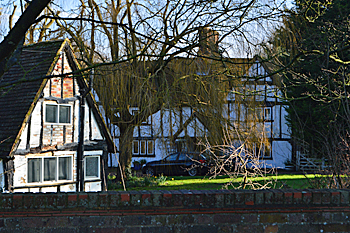Gostelow House Chalton

Gostelow House February 2016
The building today known as Gostelow House was listed by the Ministry of Works in April 1952 as Grade II, of special interest. It was then known as Old Farm. The property dates from the 16th or early 17th century and may be of the same date as nearby
Chalton Village Hall. It is timber-framed with whitewashed brick noggin, that is, the bricks are infill between the timbers. It is built in an H-plan and comprises two storeys beneath an old clay tiled roof. The porch is modern.
The name of the farm comes from the Gostelow family who were resident in the parish in the early 19th century. F Gostelow was a farmer who lost some wheat which was found in the house of Richard Jefford in Chalton [QSR1822/321 and 328]. As a farmer Gostelow may well have rented Old Farm. In Jefford's house were found: "loose straw and a few bundles of truss bound straw, pulled out of a potato pit, a flower sack with wheat and chaff about a bushel and half".
In 1838 labourer Thomas Gostelow of Chalton brought a bill against John Pateman of Toddington, labourer [QSR1838/3/4/9 and 3/5/9]. Thomas Morris of Chalton gave evidence that he was employed by Gostelow, who put him to watch the wheat barn on his farm at Chalton. The barn stood "in the farm yard with the farm house". About 1 a.m. Morris saw a man with a sack come into the yard over a gate. The man went to one of the doors of the wheat barn, which was locked. It was quite a bright moonlit night and the man was within 8 or 9 yards of the door. Morris saw the man go in and shut the door. He called his master and they went together to the barn. They saw a light in the barn which moved, and they thought the man was going out at another door. Gostelow went round towards it and the light was put out. They continued watching until a man named Medcraft came to them. They got a light and went into the barn. After a search they found Pateman standing in a part which was boarded off. There was some undressed wheat in the sack, and about two bushels of dressed wheat.
In his defence all John Pateman said was: "I know I was in the barn but I never stole no wheat". Not surprisingly he was given a severe sentence – transportation. The gaol register for Bedford Gaol [QGV10/2] tells us that Pateman was aged 41, 5 feet 6 inches tall, with dark hair and complexion and hazel eyes. He was sent abroad for fifteen years.
This may have been a case of the last straw breaking the camel's back. The name John Pateman, from Toddington, occurs in the gaol registers six times previous to this case. They may or may not be the same man but the ages and descriptions are similar:
- In 1817 John Pateman, aged 20, 5 feet 5 inches tall, with brown hair and fresh complexion was sentenced to three months in gaol for not obeying an order of filiation. His conduct in prison was described as "very indifferent" [QGV10/1];
- In August 1821 John Pateman, aged 23, 5 feet 5 inches tall, with brown hair, dark hazel eyes and a fresh complexion was sentenced to three months or a fine of £5/4/- for refusing to obey an order in bastardy (he was a married man), he was also ordered to pay maintenance of one shilling per week. His conduct in prison was described as "very good" [QDV11/]. Evidently he did not keep up the payments as he was sentenced twice more, three months each time, for breaching the same order, in February and October 1822;
- In 1824 John Pateman, aged 23, 5 feet 6 inches tall, dark hair, dark complexion was acquitted on a charge of stealing a hat [QGV10/1];
- In 1834 John Pateman, aged 37, 5 feet 5¼ inches tall, dark hair, sallow complexion, was given four months hard labour for riotous assembly [QGV10/2].
The Rating and Valuation Act 1925 specified that every building and piece of land in the country was to be assessed to determine its rateable value. The valuer visiting the property [DV1/H4/8] found that it formed part of Yew Tree Farm and that the house was derelict as it was "not required".